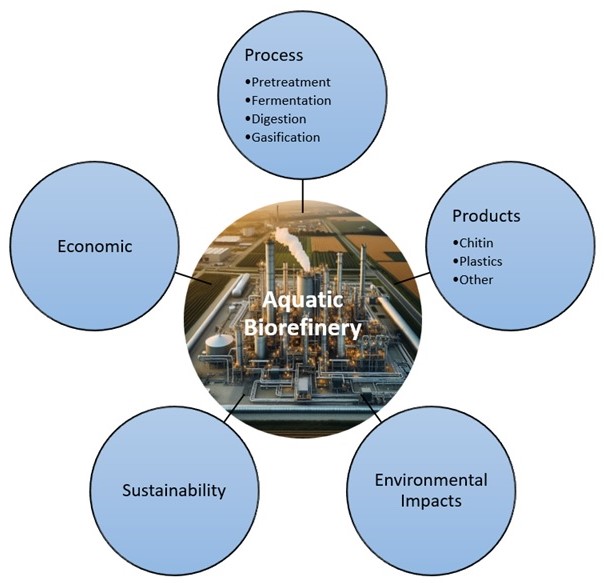ADVANCING SUSTAINABLE RESOURCE UTILISATION: A REVIEW OF AQUATIC BIOREFINERIES
DOI:
https://doi.org/10.46754/ps.2024.01.003Keywords:
Resource utilisation, Biochemical conversion, Algae cultivation, Environmental SustainabilityAbstract
This review explores the transformative potential of aquatic biorefineries in advancing sustainable resource utilisation. As global demands for renewable resources intensify, biorefineries have emerged as versatile solutions. Focusing on aquatic environments, this paper delves into diverse biomass resources, encompassing microorganisms, algae and aquatic plants. It navigates through key biorefinery processes, including hydrothermal liquefaction, algae cultivation and enzymatic conversion, illuminating their roles in sustainable biofuel and high-value chemical production. Thermochemical conversion processes, such as pyrolysis and gasification, offer additional pathways for bio-based product generation. The review critically assesses challenges in these processes, ranging from technical intricacies to regulatory considerations. Examining products derived from aquatic biorefineries (i.e. biofuels, chemicals and biomaterials) underscores their versatility. Looking ahead, the paper identifies technical challenges, regulatory landscapes and emerging technologies as focal points for future research. The review concludes by envisioning aquatic biorefineries as key players in sustainable resource management, advocating for research and technological innovation to propel this transformative field into the mainstream of the bio-based economy.
References
Adarme-Vega, T. C., Thomas-Hall, S. R., & Schenk, P. M. (2014). Towards sustainable sources for omega-3 fatty acids production. Current Opinion in Biotechnology, 26, 14-18. https://doi.org/10.1016/j. copbio.2013.08.003 DOI: https://doi.org/10.1016/j.copbio.2013.08.003
Amiri, H., Aghbashlo, M., Sharma, M., Gaffey, J., Manning, L., Moosavi Basri, S. M., Kennedy, J. F., Gupta, V. K., & Tabatabaei, M. (2022). Chitin and chitosan derived from crustacean waste valorization streams can support food systems and the UN Sustainable Development Goals. Nature Food, 3(10), 822-828. https://doi. org/10.1038/s43016-022-00591-y DOI: https://doi.org/10.1038/s43016-022-00591-y
Amulya, K., Morris, S., & Lens, P. N. (2023). Aquatic biomass as sustainable feedstock for biorefineries. Biofuels, Bioproducts and Biorefining, 17(4), 1012-1029. https://doi. org/10.1002/bbb.2471 DOI: https://doi.org/10.1002/bbb.2471
Azwar, E., Wan Mahari, W. A., Rastegari, H., Tabatabaei, M., Peng, W., Tsang, Y. F., Park, Y. K., Chen, W. H., & Lam, S. S. (2022). Progress in thermochemical conversion of aquatic weeds in shellfish aquaculture for biofuel generation: Technical and economic perspectives. Bioresource Technology, 344(Pt A), 126202.https://doi.org/10.1016/j. biortech.2021.126202 DOI: https://doi.org/10.1016/j.biortech.2021.126202
Balboa, E. M., Conde, E., Moure, A., Falqué, E., & Domínguez, H. (2013). In vitro antioxidant properties of crude extracts and compounds from brown algae. Food Chemistry, 138(2-3), 1764–1785. https:// doi.org/10.1016/j.foodchem.2012.11.026 DOI: https://doi.org/10.1016/j.foodchem.2012.11.026
Daroch, M., Geng S., & Wang, G. (2013). Recent advances in liquid biofuel production from algal feedstocks. Applied Energy, 102, 1371-1381. https://doi.org/10.1016/j. apenergy.2012.07.031 Demirbas, A. (2009). Biorefineries: Current activities and future developments. Energy Conversion and Management, 50(11), 2782-2801. DOI: https://doi.org/10.1016/j.apenergy.2012.07.031
Ellis, J. T., Hengge, N. N., Sims, R. C., & Miller, C. D. (2012). Acetone, butanol, and ethanol production from wastewater algae. Bioresource Technology, 111, 491-495.https:// doi.org/10.1016/j.biortech.2012.02.002 DOI: https://doi.org/10.1016/j.biortech.2012.02.002
Esquivel-Hernández, D.A., Ibarra-Garza, I.P., Rodríguez-Rodríguez, J., Cuéllar-Bermúdez, S.P., Rostro-Alanis, M.d.J., Alemán-Nava, G.S., García-Pérez, J.S. and Parra-Saldívar, R. (2017). Green extraction technologies for high-value metabolites from algae:A review. Biofuels, Bioproducts and Biorefining, 11(1), 215-231. DOI: https://doi.org/10.1002/bbb.1735
Kamm, B., & Kamm, M. (2004). Principles of biorefineries. Applied Microbiology And Biotechnology, 64(2), 137-145. https://doi. org/10.1007/s00253-003-1537-7 DOI: https://doi.org/10.1007/s00253-003-1537-7
Kaur, M., Kumar, M., Singh, D., Sachdeva S., & Puri, S. (2019). A sustainable biorefinery approach for efficient conversion of aquatic weeds into bioethanol and biomethane. Energy Conversion and Management, 187, 133-147. DOI: https://doi.org/10.1016/j.enconman.2019.03.018
Koyande, A. K., Chew, K. W., Manickam, S., Chang, J.-S., & Show, P.-L. (2021). Emerging algal nanotechnology for highvalue compounds: A direction to future food production. Trends in Food Science & Technology, 116, 290-302. DOI: https://doi.org/10.1016/j.tifs.2021.07.026
Kumar, B., & Verma, P. (2020). Enzyme mediated multi-product process: A concept of bio-based refinery. Industrial Crops and Products, 154, 112607. DOI: https://doi.org/10.1016/j.indcrop.2020.112607
Kumar, N., Banerjee, C., Negi, S., & Shukla, P. (2023). Microalgae harvesting techniques: updates and recent technological interventions. Critical Reviews in Biotechnology, 43(3), 342-368. https://doi. org/10.1080/07388551.2022.2031089 DOI: https://doi.org/10.1080/07388551.2022.2031089
Lee, S., Oh, Y., Kim, D., Kwon, D., Lee, C., & Lee, J. (2011). Converting carbohydrates extracted from marine algae into ethanol using various ethanolic Escherichia oli strains. Applied Biochemistry and Biotechnology, 164(6), 878-888. https:// doi.org/10.1007/s12010-011-9181-7 DOI: https://doi.org/10.1007/s12010-011-9181-7
Moreira, A., Cruz, S., Marques, R., & Cartaxana, P. (2022). The underexplored potential of green macroalgae in aquaculture. Reviews in Aquaculture, 14(1), 5-26. https://doi. org/10.1111/raq.12580 DOI: https://doi.org/10.1111/raq.12580
Nawaj Alam, S., Singh, B., & Guldhe, A. (2021). Aquatic weed as a biorefinery resource for biofuels and value-added products: Challenges and recent advancements. Cleaner Engineering and Technology, 4, 100235. DOI: https://doi.org/10.1016/j.clet.2021.100235
Pangestuti, R., & Kim, S.-K. (2011). Biological activities and health benefit effects of natural pigments derived from marine algae. Journal of Functional Foods, 3(4), 255-266. DOI: https://doi.org/10.1016/j.jff.2011.07.001
Parakh, S. K., Tian, Z., Wong, J. Z. E., & Tong, Y. W. (2023). From microalgae to bioenergy: Recent advances in biochemical conversion processes. Fermentation, 9(6), 529. DOI: https://doi.org/10.3390/fermentation9060529
Saxena, R., G. Rosero-Chasoy, E. Aparicio, A. Lara, A. Loredo, A. Robledo, E. T. Kostas, R. M. Rodríguez-Jasso and H. A. Ruiz (2022). Third generation biorefineries using micro- and macro-algae. In Fang, Z., Smith Jr R. L., & Xu. L. (Eds.), Production of biofuels and chemicals from sustainable recycling of organic solid waste (pp. 373-411). Singapore: Springer Nature Singapore. DOI: https://doi.org/10.1007/978-981-16-6162-4_12
Schnurr, P. J., & Allen, D. G. (2015). Factors affecting algae biofilm growth and lipid production: A review. Renewable and Sustainable Energy Reviews, 52, 418-429. DOI: https://doi.org/10.1016/j.rser.2015.07.090
Scholten, P. B. V., & Figueirêdo, M. B. (2022). Back to the future with biorefineries: Bottom-up and top-down approaches toward polymers and monomers. Macromolecular Chemistry and Physics, 223(13), 2200017. DOI: https://doi.org/10.1002/macp.202200017
Shahbeik, H., H. Kazemi Shariat Panahi, M. Dehhaghi, G. J. Guillemin, A. Fallahi, H. Hosseinzadeh-Bandbafha, H. Amiri, M. Rehan, D. Raikwar, H. Latine, B. Pandalone, B. Khoshnevisan, C. Sonne, L. Vaccaro, A.S. Nizami, V. K. Gupta, S. S. Lam, J. Pan, R. Luque, B. Sels, W. Peng, M. Tabatabaei, & M. Aghbashlo (2024). Biomass to biofuels using hydrothermal liquefaction: A comprehensive review. Renewable and Sustainable Energy Reviews, 189, 113976. DOI: https://doi.org/10.1016/j.rser.2023.113976
Shahbeik, H., W. Peng, H. Kazemi Shariat Panahi, M. Dehhaghi, G. J. Guillemin, A. Fallahi, H. Amiri, M. Rehan, D. Raikwar, H. Latine, B. Pandalone, B. Khoshnevisan, C. Sonne, L. Vaccaro, A.-S. Nizami, V. K. Gupta, S. S. Lam, J. Pan, R. Luque, B. Sels, M. Tabatabaei and M. Aghbashlo (2022). Synthesis of liquid biofuels from biomass by hydrothermal gasification: A critical review. Renewable and Sustainable Energy Reviews, 167, 112833. Song, M., Fisher, R., & Kwoh, Y. (2019). Technological innovation challenges of green and sustainable resource management with large scale data. Technological Forecasting and Social Change, 144, 361-368. DOI: https://doi.org/10.1016/j.rser.2022.112833
Tabatabaei, M., Tohidfar, M., Jouzani, G. S., Safarnejad M., & Pazouki, M. (2011). Biodiesel production from genetically engineered microalgae: future of bioenergy in Iran. Renewable and Sustainable Energy Reviews, 15(4), 1918-1927. DOI: https://doi.org/10.1016/j.rser.2010.12.004
Trivedi, J., Aila, M., Bangwal, D. P., Kaul, S., & Garg, M. O. (2015). Algae based biorefinery—How to make sense? Renewable and Sustainable Energy Reviews, 47, 295307. DOI: https://doi.org/10.1016/j.rser.2015.03.052
Wells, M. L., Potin, P., Craigie, J. S., Raven, J. A., Merchant, S. S., Helliwell, K. E., Smith, A. G., Camire, M. E., & Brawley, S. H. (2017). Algae as nutritional and functional food sources: revisiting our understanding. Journal of Applied Phycology, 29, 949-982. DOI: https://doi.org/10.1007/s10811-016-0974-5
Xiaogang, H., Jalalah, M., Jingyuan, W., Zheng, Y., Li X., & Salama, E.-S. (2020). Microalgal growth coupled with wastewater treatment in open and closed systems for advanced biofuel generation. Biomass Conversion and Biorefinery, 12, 1-20. DOI: https://doi.org/10.1007/s13399-020-01061-w
Yadav, G. and R. Sen (2018). Sustainability of microalgal biorefinery: Scope, challenges, and opportunities. In S. De, S. Bandyopadhyay, M. Assadi & Mukherjee D. A. (Eds.), Sustainable energy technology and policies: A transformational journey (Volume 1, pp. 335-351). Singapore: Springer Singapore. DOI: https://doi.org/10.1007/978-981-10-7188-1_15
Zhou, Y., Liu, L., Li, M., & Hu, C. (2022). Algal biomass valorisation to highvalue chemicals and bioproducts: Recent advances, opportunities and challenges. Bioresource Technology, 344, 126371. DOI: https://doi.org/10.1016/j.biortech.2021.126371

Downloads
Published
How to Cite
Issue
Section
License
Copyright (c) 2024 Planetary Sustainability

This work is licensed under a Creative Commons Attribution-ShareAlike 4.0 International License.




